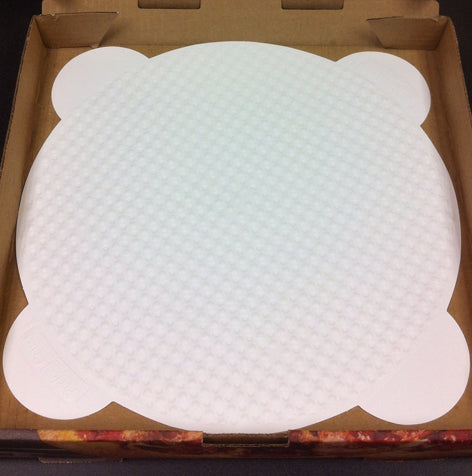Everything You Need to Know About PFAS

Today, climate change is the greatest threat to our future. And while there are monumental undertakings happening all across the world to combat it, one of the biggest causes of climate destruction is all around us, too small to see. We’re talking about PFAS.
Per-and polyfluoroalkyl substances (PFAS) are chemicals used in everything from retail products to personal care items: almost anything you can buy in the store these days. And, in fact, these damaging chemicals are a staple in the food packaging sector. Fast food packaging—including pizza delivery boxes—are often made with PFAS, to the detriment of both nature and consumers.
Here’s what you need to know about these chemicals, and how the fast-food industry can play its part in safeguarding humans, animals and the environment by ditching PFAS.
What is PFAS?
PFAS are a group of “forever chemicals” used in fluoropolymer coatings and products. They’re oleophobic and hydrophobic, which means they’re often used in applications where heat-, oil-, stain-, grease- and water-resistance is critical. When it comes to fast food, this encompasses just about every type of packaging!
The problem with PFAS is that they’re permanent: they’re substances that won’t break down. They can’t be recycled by the environment, but they can move through just about anything, from bodies of water to animals, and even human bodies. This means that humans are exposed to PFAS on a near-daily basis. Even as far back as 2019, it was discovered that exposure to PFAS begins in utero! That means no one born today will ever experience life without PFAS exposure.
PFAS are in the environment and, right now, there’s no way to get rid of them. Worse still, every piece of fast-food packaging produced means a higher potential for exposure. It’s a trend that needs to stop.
How does PFAS affect our bodies?
With the ever-present threat of PFAS all around us, it’s natural to be concerned about its potential for harm.
Research is ongoing and the full effects of PFAS on the human body aren’t yet known; however, the Environmental Protection Agency (EPA) has confirmed that excessive exposure to PFAS creates the potential for major problems. And, in fact, we might still be understating the dangers of PFAS.
A recent study by the U.S. Centers for Disease Control and Prevention (CDC) details a full range of negative health effects associated with PFAS exposure, including:
- Cancer
- Decreased fertility
- Increased risk of asthma
- Increased risk of thyroid disease
- Liver damage
In laboratory studies, exposure to large amounts of PFAS shows that the substances may affect growth and development in animals, and may even compromise the immune system.
While more research is needed to understand the full scope of PFAS and their impact on the human body, the best way to mitigate the potentially harmful effects of these substances is to avoid them as much as possible. It’s an increasingly difficult task.
How does PFAS impact the environment?
Manufacturing is the greatest source of PFAS production, and they enter the environment via waste streams found nearly everywhere around the world. Once they enter the soil, it can take up to 1,000 years for these chemicals to degrade—hence the nickname, “forever chemicals.”
The U.S. EPA has moved quickly to propose regulations that limit PFAS in water and waste. Unfortunately, very few PFAS are regulated for their toxicity and prevalence. Even something as seemingly simple and practical as PFAS-free food packaging can play a role in preventing more of these harmful chemicals from entering the environment.
A look at PFAS in food packaging
As mentioned, PFAS are a critical component in creating no-mess food packaging. However, its benefits don’t come close to outweighing the damage these chemicals cause to the environment. It’s such a problem that nine states—CA, CO, CT, MD, ME, MN, NY, VT and WA—have enacted statewide bans on PFAS chemicals in food packaging.
Takeout pizza boxes, in particular, contain high amounts of PFAS to prevent grease and oil from seeping out of the container. As more states look to ban PFAS from food packaging, pizza operators need to seek alternatives to many of the everyday items they use to package their pies, from wax paper to corrugated sheets, mesh and more.
A commitment to PFAS-free packaging
Pizza operators have a role to play in creating a more sustainable future—one that’s free from the threat of forever chemicals like PFAS. By taking a mindful approach to something as simple as packaging, they can play a part in reducing the impact of PFAS on both people and the environment.
Perfect Crust Pizza Liners are one innovative product that seeks to eliminate PFAS from the pizza delivery equation. They make packaging liners that are PFAS-free, biodegradable and composable, serving as a grease-proof barrier between the pizza box and the pizza. When you consider that Americans eat billions of pizzas each year, even something as simple as a pizza box liner can have a big impact.
If you’re concerned about the effect of PFAS on your health and the environment, consider the food you’re eating first. No one says you need to give up pizza—you just need to make sure it’s delivered in PFAS-free packaging. it’s what’s good for you and the environment.




